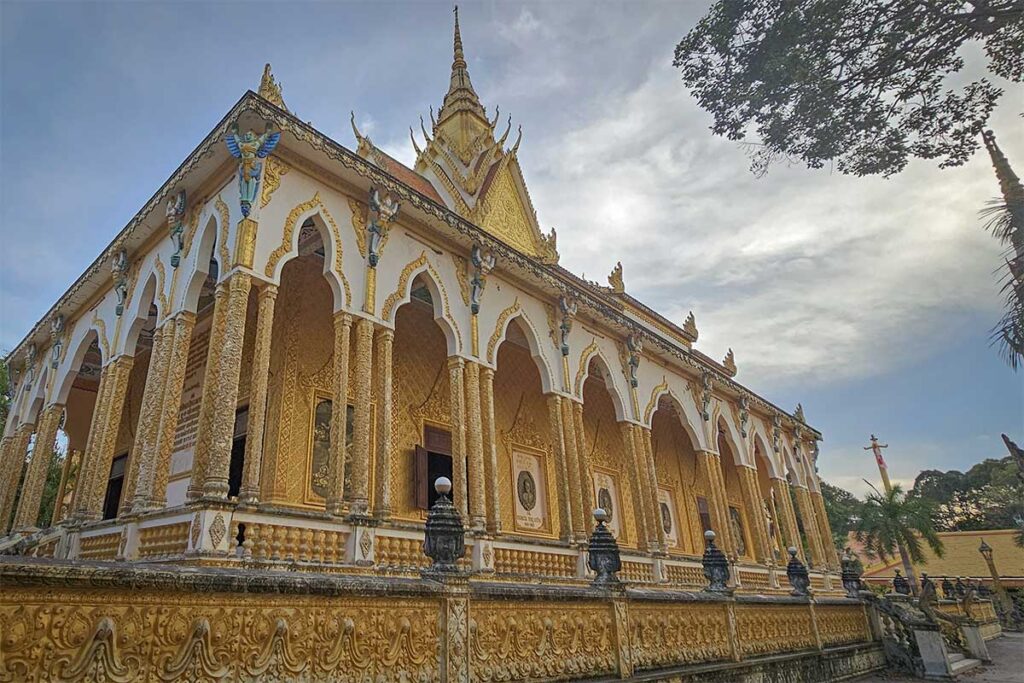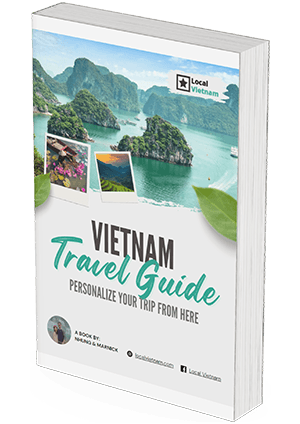What is Nodol Pagoda (Stork Temple)?
Location and Setting
Nodol Pagoda, often called the Stork Temple or Co Pagoda, is located in Dai An commune, Tra Cu district, about 40 kilometers south of Tra Vinh City. The temple sits in a quiet rural setting, surrounded by rice paddies and shaded by bamboo, star, and oil trees.
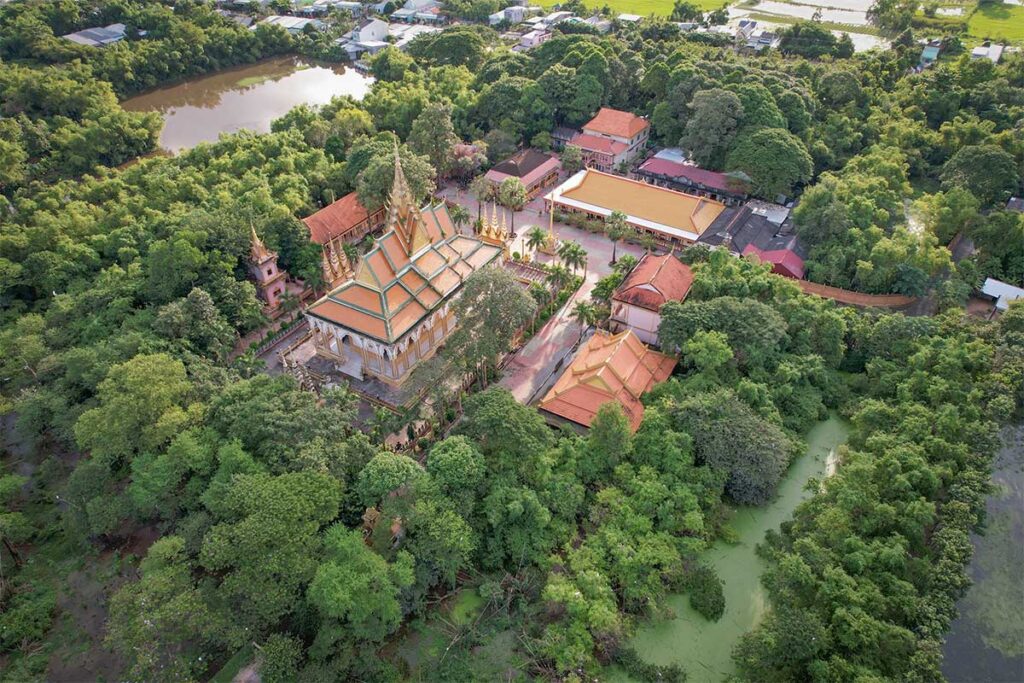
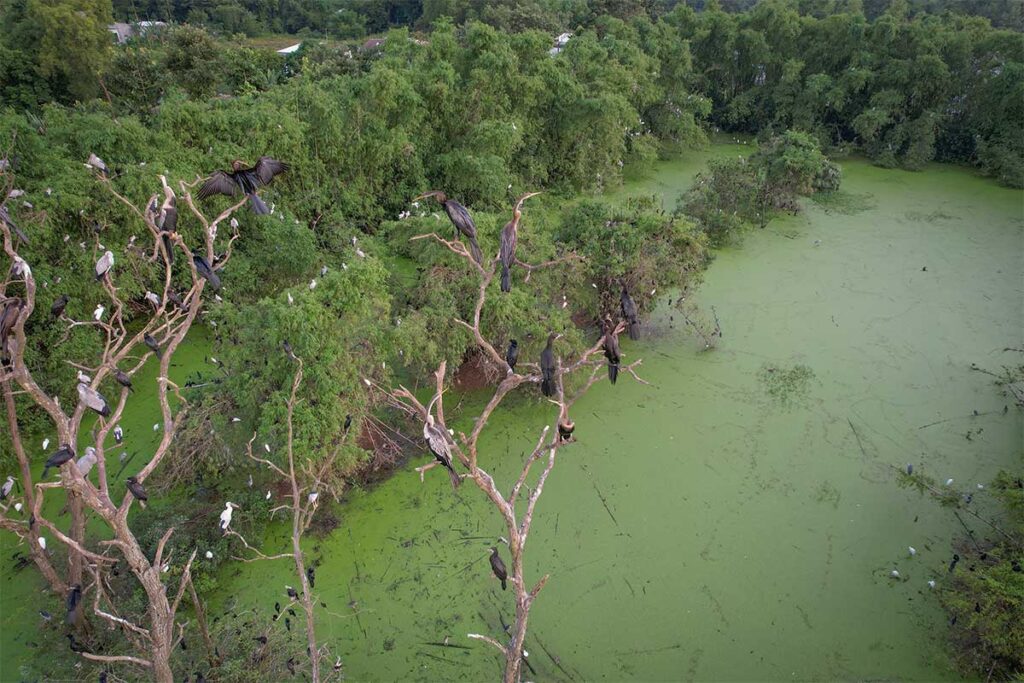
These tall trees not only frame the pagoda but also provide the natural habitat that attracts thousands of storks and herons. The setting feels more like a countryside retreat than a major tourist site, which is part of its charm for those exploring off the beaten track in the Mekong Delta.
History of the Pagoda
The pagoda was founded in 1677, making it more than 300 years old and one of the oldest Khmer temples in the region. Its original Khmer name is Wat Phnom Don, but over time locals began calling it Co Pagoda, or Stork Temple, because of the large bird colonies that settled here. Like many temples in southern Vietnam, it has been restored and rebuilt multiple times to withstand the tropical climate and historical upheavals—most notably in 1944, 1968, and during the early 2000s. While not as monumental as the great temples of Cambodia, it reflects the strong Khmer Buddhist traditions that continue to shape the identity of Tra Vinh.
Daily use and Role today
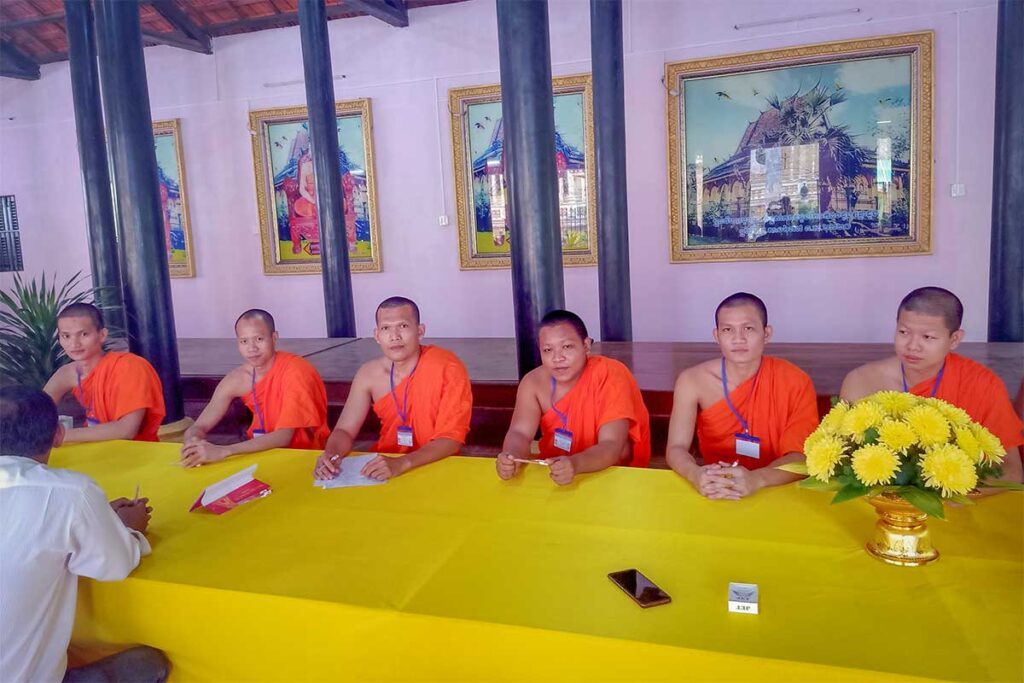
Nodol Pagoda is not just a tourist stop—it remains an active place of worship and community gathering. Monks live and study here, and ceremonies for the Khmer Buddhist calendar are held throughout the year. The grounds also function as a sanctuary for wildlife, particularly storks, which locals and monks have protected for generations. Their presence gives the pagoda a unique atmosphere, where the sound of chanting sometimes blends with the calls of birds overhead. For visitors, this mix of cultural and natural life is what makes Nodol Pagoda stand out compared to many other pagodas in Vietnam.
Highlights of visiting Nodol Pagoda
1. Khmer architecture

The architecture of Nodol Pagoda reflects the typical style of Khmer temples in southern Vietnam, though on a smaller scale than what you might see in Cambodia. The temple gate is brightly decorated with intricate patterns and motifs, immediately catching the eye.
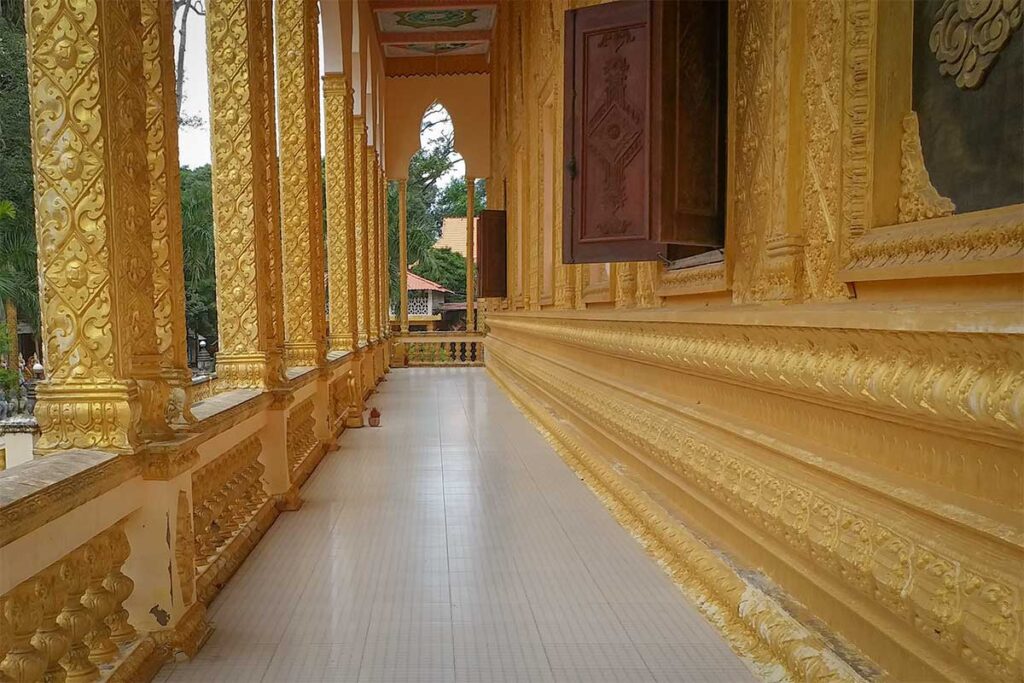
The main hall stands out with its curved rooflines shaped like a dragon’s tail and pointed peaks meant to resemble sacred mountains. Look closely and you’ll see familiar figures from Khmer mythology, including the four-faced god Mohabrom, the demon Rahu, and the bird-like Krud.
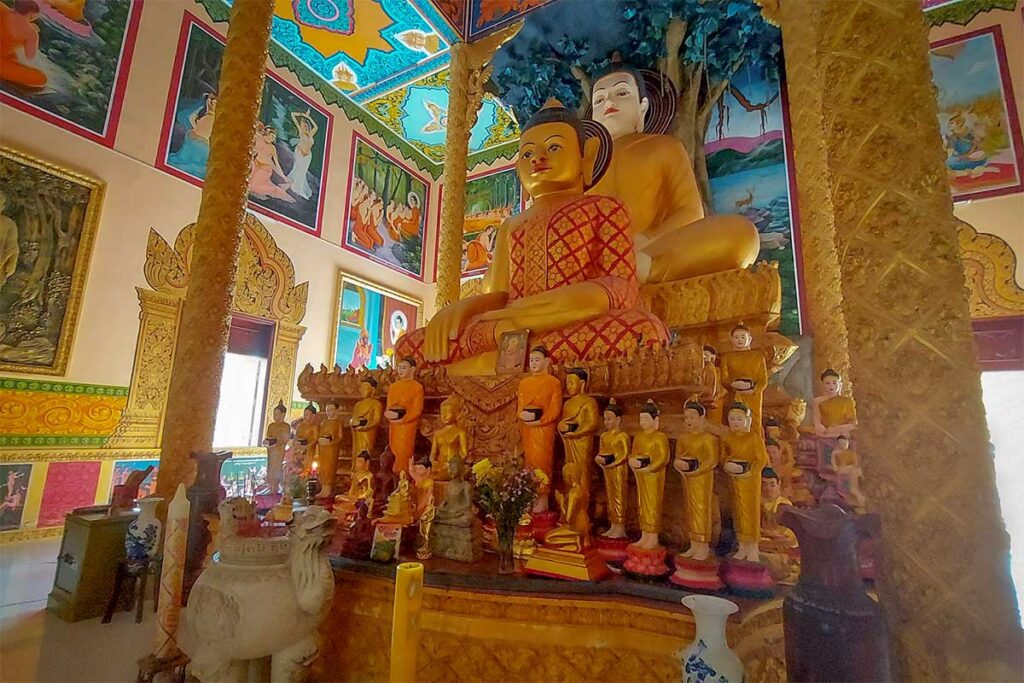
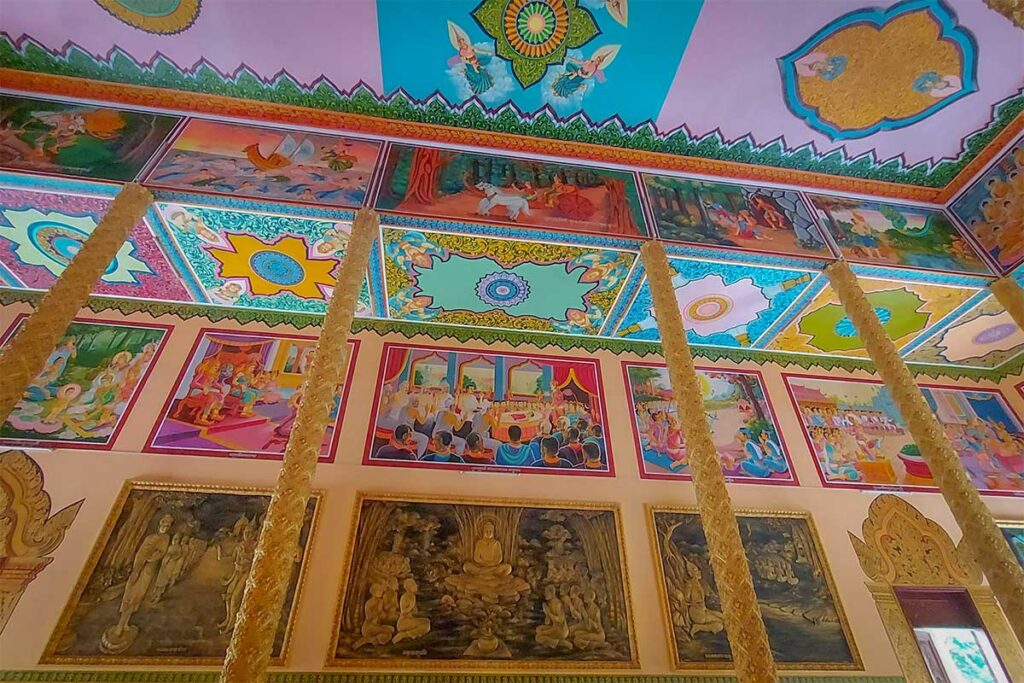
Inside, the space is solemn and colorful at the same time. A large statue of Shakyamuni Buddha dominates the hall, while the walls are covered in vivid murals that tell Buddhist stories and teachings.
2. Birdlife – The storks

What makes this temple unique compared to other Khmer pagodas is its birdlife. For over a century, storks have chosen the tall trees around the pagoda as their nesting ground. Today, thousands of storks and herons live here, alongside rarer species such as the snake-necked stork. The best time to see them is early in the morning when they take flight, or late in the afternoon when they return from the fields. It’s an unusual sight: the solemn atmosphere of a Buddhist temple combined with the noisy calls of birds overhead. That said, while the storks are a permanent colony, spotting them clearly isn’t always guaranteed—sometimes they stay high in the treetops.
3. Temple grounds and Atmosphere
The grounds of Nodol Pagoda are spacious and green, with bamboo groves, star trees, and oil trees providing shade. Beyond the pagoda walls stretch endless rice fields, giving the place a calm, rural character. Visitors often remark that the atmosphere is both spiritual and natural: part functioning temple, part bird sanctuary. It’s not polished like a major tourist attraction, but that’s part of its appeal—you come here to slow down and take in the mix of culture and countryside.
4. Other features inside the complex


Aside from the main hall, the complex includes several other structures. There are stupas or cremation towers, which are typically used to hold the ashes of monks. Nearby, you’ll find the monastic living quarters and study halls, where the daily life of the temple community unfolds. Scattered around the grounds are statues of sacred animals such as elephants and snakes, reflecting Khmer symbolism. While not all of these features are as visually striking as the main hall, together they give visitors a sense of the temple’s religious and cultural importance.
Practical visiting information & Tips
Location & How to get there
Nodol Pagoda is located about 40 kilometers south of Tra Vinh City, which takes roughly an hour to reach by road. If you’re traveling from Ho Chi Minh City, expect a 4.5 to 5 hour journey by car or bus. From Can Tho, the drive is shorter at around 2.5 hours. The easiest way to visit is by private car with a driver, which allows you to combine the pagoda with other sights in the area. Confident riders can also rent a motorbike and enjoy the quiet countryside roads, but be prepared for basic conditions in some stretches.
Entrance & Opening hours
There is no entrance fee for the pagoda, though donations are appreciated. There are also no official opening hours—the gates are generally open, and visitors can walk in freely. For practical reasons, it’s best to visit during daylight hours when the grounds are active and safe to explore.
Dress code & Etiquette
As with any temple visit in Vietnam, modest clothing is expected. Covering shoulders and knees is a sign of respect, and you should remove your shoes when entering the main hall. Avoid touching or climbing on statues, which are considered sacred. Monks do not ask for money, but if you’d like to make a donation, there are discreet boxes where you can contribute.
Best time to visit
The temple is accessible year-round, though the dry season offers more comfortable weather for traveling around Tra Vinh. If your main interest is the storks, the best times to see them are at sunrise, when they leave their nests, or at sunset, when they return from feeding. During midday, they often rest high in the trees and can be harder to spot.
Other things to do nearby
While the pagoda itself doesn’t take long to explore, it pairs well with other attractions in Tra Vinh. Vam Ray Pagoda, Ba Om Pond, and Truc Lam Zen Monastery are all worth considering if you’re planning a full day. Con Chim Islet is another interesting stop for those curious about rural life and eco-tourism. Cycling through Khmer villages in the area is also a rewarding way to experience the countryside. For a broader overview of what to see and do, check out our full Tra Vinh travel guide.
Is Nodol Pagoda worth visiting?
Nodol Pagoda is worth visiting if you’re already exploring Tra Vinh or want to see something a little different in the Mekong Delta. The mix of Khmer Buddhist culture and a living bird sanctuary makes it stand out from other temples in Vietnam.
At the same time, it’s fair to say this is not the most spectacular Khmer pagoda you’ll ever see—if you’ve traveled in Cambodia or Thailand, the architecture here will feel more modest. The storks add a special atmosphere, though you’re not guaranteed dramatic views every time, as they often stay high in the trees. Taken on its own, the pagoda isn’t a strong enough reason to make the long trip from Ho Chi Minh City. But combined with other sights like Ba Om Pond, Vam Ray Pagoda, or Con Chim Islet, it makes for a worthwhile stop in a broader Tra Vinh itinerary.
